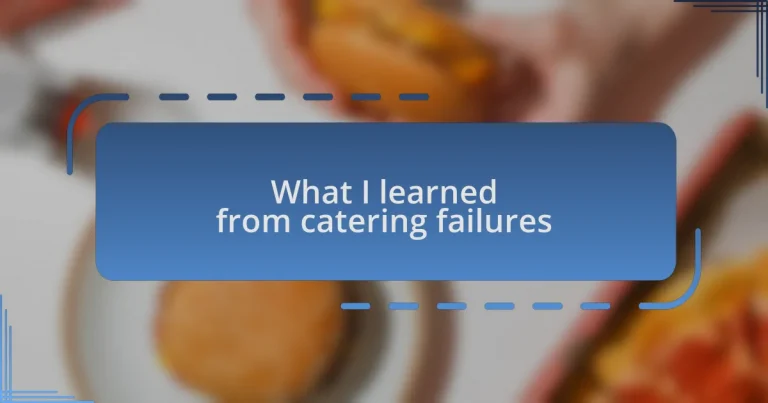Key takeaways:
- Catering failures often stem from miscommunication, logistical challenges, and unforeseen circumstances, emphasizing the need for attention to detail and adaptability.
- Gourmet burgers serve not only to delight diverse palates but also symbolize trends towards quality, sustainability, and innovative culinary experiences.
- Customer feedback is essential for refining offerings and fostering community; it can lead to improved dishes and a better understanding of customer preferences.
- Learning from past mistakes, such as inventory mismanagement and underestimating demand, is crucial for enhancing service and menu development.
Author: Olivia Hartwell
Bio: Olivia Hartwell is a contemporary fiction author known for her compelling narratives and vivid characterizations. With a background in literature and creative writing, she has a keen eye for detail and a passion for exploring the complexities of human relationships. Olivia’s debut novel, Whispers of the Heart, received critical acclaim and was nominated for several literary awards. When she’s not writing, she enjoys hiking in the mountains of Colorado and sipping artisanal coffee at local cafes. Olivia resides in Denver with her beloved rescue dog, Rosie.
Understanding catering failures
Catering failures can feel like a punch to the gut, especially when you’ve invested so much time and energy into planning. I remember once prepping for an outdoor event, only to discover I had mismatched the order quantities. It was chaos as we scrambled to keep guests fed, and honestly, it was a humbling reminder of the importance of attention to detail. Don’t you think that a small oversight can snowball into a larger problem when you’re under pressure?
Another major factor in catering mishaps is communication. I’ve had moments where what I thought was clear became wildly misunderstood. For example, during a wedding, the couple wanted a specific dish, but somehow the message got lost in translation, and that dish didn’t make it to the lineup. Reflecting on that, I realized how vital it is to confirm orders and double-check details — a simple confirmation could have saved us so much stress. Have you ever faced a similar situation where assumptions led to unexpected outcomes?
Lastly, unforeseen circumstances can throw even the best plans into disarray. I recall once battling an unexpected rainstorm just before an event, where all my careful setup plans went out the window. Panic set in, and I learned that flexibility and quick thinking are just as crucial as preparation itself. How do you cope when the unexpected hits? Embracing adaptability can turn a potential disaster into a memorable experience, but it takes practice and resilience.
Importance of gourmet burgers
Gourmet burgers hold a special place in the culinary landscape, elevating a simple meal into a gourmet experience. I once watched in awe as a well-crafted burger made from fresh, high-quality ingredients transformed an ordinary gathering into a gastronomic event. Isn’t it fascinating how a perfectly cooked patty, paired with exquisite toppings, can evoke such delight? This reveals the power gourmet burgers have to create unforgettable moments around the dining table.
Moreover, gourmet burgers cater to diverse tastes and dietary preferences, showcasing creativity and innovation. A while back, I hosted a tasting event where each burger represented a different cuisine, from Mexican-inspired to Asian fusion. The excitement around trying something new was palpable! This diversity not only pleases a wider audience but also allows chefs to experiment and express their culinary flair. Have you ever found a new favorite dish simply because someone dared to think outside the box?
Lastly, the importance of gourmet burgers extends beyond taste; they symbolize the trend towards quality, sustainability, and ethical sourcing in food. At one of our events, I noticed guests gravitating towards burgers made from grass-fed beef and local vegetables. It struck me that people are hungry for more than just flavor – they crave a connection to the food they eat. This trend, in my experience, invites a conversation about mindful eating and the impact of our choices on the planet. How can we, as consumers, encourage this movement while enjoying every delicious bite?
Challenges in mobile catering
When it comes to mobile catering, one of the biggest hurdles I’ve faced is managing logistics on the go. There’s nothing quite like the realization that your truck is parked in an area with limited space for food prep and serving. I remember a particularly chaotic event where we were squeezed between two other trucks, leading to longer wait times and frustrated customers. It’s a stark reminder of how vital it is to plan the layout efficiently, ensuring smooth service no matter the venue.
Another challenge is dealing with unpredictable weather conditions. I once set up for a bustling festival, only to be met with unexpected rain showers. Watching the raindrops pelt my freshly prepared ingredients was disheartening! It taught me the hard way that having a backup plan, like protective coverings and indoor options, is crucial in preserving not just the food, but also the spirit of the event. Have you ever had to adapt quickly to nature’s whims?
Additionally, I’ve found that customer expectations can vary widely in a mobile setting. At one outdoor event, I encountered a group who expected fine dining service but were met with a food truck’s casual experience. Their disappointment was palpable, and it drove home the importance of clear communication about what we offer. I learned that effectively setting expectations can go a long way in ensuring every customer leaves satisfied—even if it means being upfront about the casual, yet gourmet, nature of my services. How do you navigate customer expectations in your own experiences?
Learning from past mistakes
Learning from past mistakes is crucial in refining our approach to catering. I recall an event where I underestimated the cooking time for a new gourmet burger recipe. As the line of eager customers grew longer, the growing frustration around me was palpable. That experience reminded me that testing recipes before big events isn’t just a good idea; it’s essential.
I’ve also learned that forgetting to double-check my inventory can lead to embarrassing situations. During one busy weekend, we ran out of key ingredients midway through service. The looks on my customers’ faces were a mix of disappointment and confusion. It taught me that meticulous planning and inventory management can prevent those cringe-worthy moments and help maintain customer trust.
Sometimes, the lessons come from unexpected places. I remember a particularly harsh bit of feedback from a customer after an event. At first, it stung, but upon reflection, it spurred me to rethink my approach to customer feedback. I’ve since embraced every critique as a valuable opportunity to improve, understanding that growth often comes from the most uncomfortable experiences. Have you ever turned a negative experience into a stepping stone for better service?
Improving menu offerings
Improving menu offerings is an ongoing journey. I vividly remember the time I introduced a special burger that I was particularly proud of—a fusion of flavors that I thought would be a hit. However, I quickly learned that not everyone shared my enthusiasm. That moment was a wake-up call; it reminded me that not every creative idea resonates with every palate, and it sparked a realization: market testing is invaluable.
There was another instance when I decided to streamline our menu to focus on fewer items, hoping to improve efficiency and quality. Initially, I was met with excitement from my team, but I soon discovered that our regular customers felt their favorite choices were missing. Hearing them express disappointment drove home the point that balancing creativity with customer preferences is vital. Have you ever had a favorite dish taken off the menu? It can feel like a personal loss.
Crafting a winning menu means embracing customer feedback and adjusting offerings accordingly. I’ve started actively soliciting opinions during events, asking patrons which burgers they loved the most or if there was something they wished to see. It’s turned out to be immensely rewarding—many customers appreciate having a voice, and I benefit from insights that help guide my menu development. Isn’t it fascinating how a few conversations can lead to dishes that truly resonate with people?
Customer feedback and its value
Customer feedback is like a treasure map leading to better decisions and offerings. I recall a time when I received a comment from a customer who pointed out that our spicy sauce overwhelmed the flavors of the burger. At first, I felt defensive—how could they not appreciate my bold creation? However, after considering their perspective, I realized that the harmony of flavors is essential. That feedback pushed me to refine my recipes and create a balance that kept everyone happy. It made me wonder, how many hidden gems in our customer’s minds could I uncover with just a little patience?
Listening to customers can also foster a sense of community. One evening, while chatting with regulars at the truck, they mentioned craving a vegetarian option. Their passion was contagious, and it sparked an idea for a new menu item. The pride I felt when unveiling that burger—crafted from their inspiration—was unparalleled. When I saw their faces light up with delight, I knew I had tapped into something genuine, reinforcing how vital these conversations are. Isn’t it remarkable how one suggestion can lead to something that brings joy to so many?
Moreover, I’ve come to understand that feedback isn’t just about fixing issues; it’s about growth. After a particularly tough event where sales didn’t meet expectations, I sent out a survey to gather thoughts. The responses ranged from praises for our service to constructive criticism about wait times and burger sizes. Surprising as it was, that data reshaped my approach for future events, reminding me that every opinion holds potential for change. Have you ever noticed how the very act of soliciting feedback can turn a tense moment into an opportunity for connection?
Personal lessons from my experience
One memorable experience that taught me about the importance of preparation involved a bustling Saturday afternoon. We underestimated the demand for our gourmet burgers, and within a few hours, we ran out of our most popular options. The disappointment on customers’ faces still echoes in my mind. I learned that no matter how confident I felt about our initial estimates, being prepared for any scenario is crucial. After all, isn’t it disheartening to watch potential loyal customers walk away empty-handed?
Another lesson came during a catering event where I tried to impress everyone with an elaborate menu. Juggling too many complex orders led to confusion and delays. I remember the anxiety curling in my stomach as I noticed patrons waiting far too long. This experience taught me the value of simplicity—sometimes, sticking to the classics can be more impressive than ornate creations. Have you ever found that the simplest ideas often resonate the most?
Lastly, there was a day when my team and I laughed through errors that seemed catastrophic at the moment. One time, I miscalculated the spice levels for a batch of burgers, and the result was too fiery for even the most adventurous of eaters. Instead of panicking, we turned the mishap into a playful “fire challenge,” inviting customers to brave the heat. That experience highlighted the need for adaptability and the joy in embracing imperfection. How often do we let unexpected turns lead to delightful surprises?


